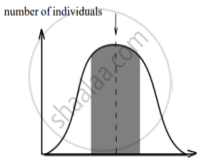Advertisements
Advertisements
प्रश्न
A population of 200 fruit flies is in Hardy Weinberg equilibrium. The frequency of the allele (a) 0.4. Calculate the following:
Frequency of the allele (A).
उत्तर
In Hardy Weinberg, p2 + 2pq + q2 = 1, where 'p2' is the frequency of the homozygous dominant genotype (AA), '2pq' is the frequency of the heterozygous genotype (Aa), and 'q2' is the frequency of the homozygous recessive genotype (aa).
Given:
q = 0.4
We know p + q = 1
p = 1 − q
= 1 − 0.4
= 0.6
Frequency of allele, p(A) = 1 − 0.4
= 0.6
APPEARS IN
संबंधित प्रश्न
With the help of an algebraic equation, how did Hardy-Weinberg explain that in a given population the frequency of occurrence of alleles of a gene is supposed to remain the same through generations?
State Hardy-Weinberg’s principle.
According to the Hardy-Weinberg principle, the allele frequency of a population remains constant. How do you interpret the change of frequency of alleles in a population?
Multiple choice question.
In Hardy - Weinberg equation, the frequency of homozygous recessive individual is represented by:
In the Hardy-Weinberg equilibrium equation, the homozygous mutant is represented as ______.
(p + q)2 = p2 + 2pq + q2 = 1 represents an equation used in ______.
The graphs below show three types of natural selection. The shaded areas marked with arrows show the individuals in the population who are not selected. The dotted vertical lines show the statistical means.
 |
 |
 |
| character Graph A |
character Graph B |
character Graph C |
- What names are given to the types of selection shown in graphs A, B and C?
- After the selection has operated for several generations in the above populations indicated as, Graph A, B and C, graphically illustrate the probable results.
Write Hardy Weinberg's equation.
A population of 200 fruit flies is in Hardy Weinberg equilibrium. The frequency of the allele (a) 0.4. Calculate the following:
The number of carrier fruit flies.
The black colour on the beak of finches dominates over the yellow colour. There are 210 individuals with the genotype DD, 245 individuals with the genotype Dd and 45 individuals with the genotype dd. Deduce the frequency of individuals with dominant, heterozygous, and recessive traits.
